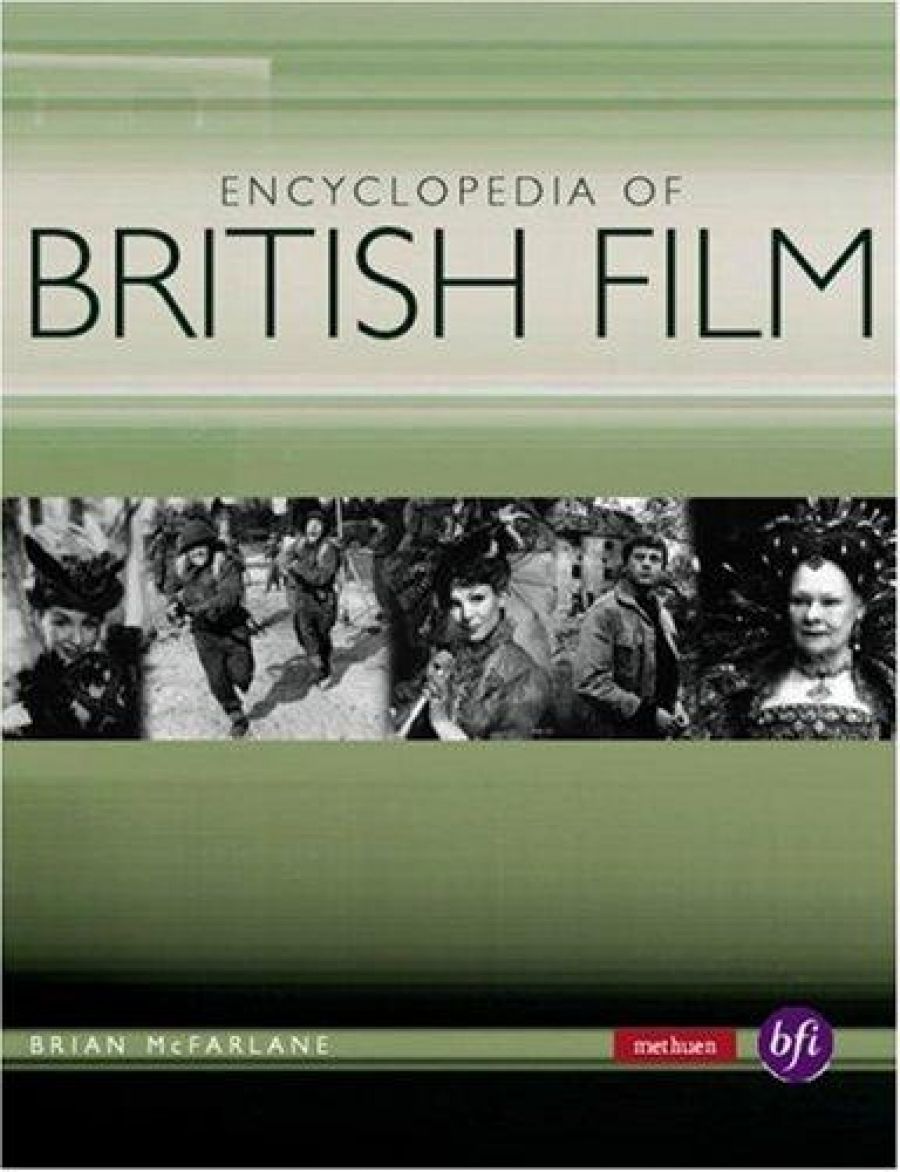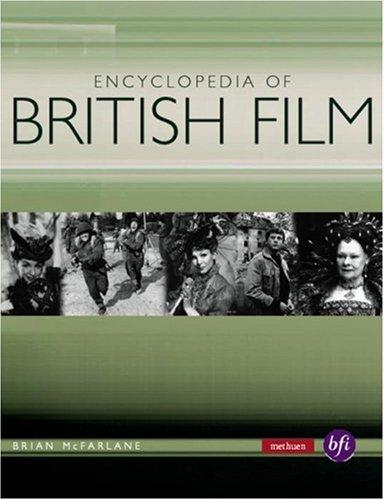
- Free Article: No
- Contents Category: Non-fiction
- Review Article: Yes
- Online Only: No
- Custom Highlight Text:
In the late 1960s the English film scholar Alan Lovell presented a paper on British cinema to the British Film Institute. His paper’s title, ‘The British Cinema: An Unknown Cinema’, seemed a reasonable assessment of the situation at that time. Film studies was establishing itself as a legitimate area of intellectual and academic research in Britain; film courses were being set up in universities, with some lecturing positions funded by the British Film Institute; and academic and trade presses had embarked on a vigorous programme devoted to books on cinema. Even so, the initial flurry of film books favoured American genres (the western, the gangster film) and American and European directors.
- Book 1 Title: The Encyclopedia of British Film
- Book 1 Biblio: Methuen/BFI, $49.95pb, 774pp
- Book 1 Cover Small (400 x 600):

- Book 1 Cover (800 x 1200):

In 1997 Lovell updated his piece, now calling it, ‘The British Cinema: The Known Cinema’. Things had changed greatly in the period between the two versions of his article. That shift is mentioned by the English film critic Philip French in his foreword to the very welcome The Encyclopedia of British Film. French remembers a time when ‘we were not encouraged to like British cinema as an institution’, since preference would always be for European art cinema or for Hollywood films. Francois Truffaut’s celebrated putdown of British cinema – ‘there is a certain incompatibility between the words “British” and “cinema”’ – prevailed for a while (from a man who, as French observes, counted Chaplin and Hitchcock among his greats), but the history of British cinema ‘is in fact a rich and fascinating story, an essential thread in world cinema and a central part of the social and cultural history of twentieth-century Britain’.
In his foreword, French notes that much attention has been paid to British cinema over the last twenty-five years, ‘much of it coming from academe, whether out of true enthusiasm or the searching for virgin territory’. One knows what he means, but many good books are now available on most periods and genres of British film-making. There are studies by the decade, with books such as Sixties British Cinema, genre collections on British Crime Cinema, British Horror Cinema, British Science Fiction Cinema, The British Historical Film; eleven British films are included in the first seventy volumes of the British Film Institute’s ‘Film Classics’ series; the historical overview collection The British Cinema Book is now in its second edition; and presses such as Routledge, OUP, BFI and Leicester University Press continue the work.
Like many Australians born in the early 1950s, I associate an initial exposure to British cinema with double features in suburban cinemas and screenings on the ABC on weekend afternoons. At no point do I remember thinking of British cinema as inferior to Hollywood cinema. It was sufficiently different from Australia, while also being somehow familiar, to be fascinating. If the Brits were being critical of their national cinema, other nations were enjoying, appreciating and valuing the same cinematic objects. Think of how Michael Powell and other British filmmakers fascinated Martin Scorsese.
In his introduction, the Australian editor of this volume, Brian McFarlane, says that the encyclopedia ‘has been compiled out of enormous affection for and pleasure in British cinema’. The 5800 entries on individuals (‘talent’ as the film industry would put it) and institutions (studios, film magazines, funding bodies, film genres) are written by an international array of experts, many of whom have also written more than one book on some aspect of British cinema.
As with any cultural encyclopedia, one quickly finds oneself skipping all over the place, far from the initial searching out of a particular entry. Such books encourage hopscotch reading as you make your way through an entry on a particular person only to find other people and films in which you have an interest. And so off one goes. As the hours pass, you know why Anouk Aimée has an entry, that five St Trinians films were made, and are intrigued to learn that Robert Bloch (author of the novel Psycho, from which Hitchcock’s film was adapted) merits an entry on the basis of his association with a series of 1960s and 1970s British horror films. The possibility of being lured deeper into arcane pursuits of topics and interlinkings seems almost infinite. Thank goodness there are only 5800 entries.
Oddly enough, as I read through this book, always entertained and informed, always admiring the expertise it contains, I wondered if it might not be the last volume of this kind. There are separate entries on ‘Scotland in Film’, ‘Wales in Film’ and ‘Ireland in Film’. An earlier, smaller (250 entries) book, The Companion to British and Irish Cinema (BFI/Cassell, 1996) was edited by a Scot (John Caughie) and an Irishman (Kevin Rockett), and one can imagine publishers dedicating individual encyclopedias to each national cinema, rather than subsuming all to the category of ‘British’.
The Irish Film Institute already has a series of books on ‘Irish Film Classics’ (following the successful BFI ‘Film Classics’ and ‘Modern Classics’ series), and individual volumes exist on classic Scottish films. Australia has recently started a series on ‘Australian Screen Classics’, with three volumes published so far: on Walkabout, The Devil’s Playground and the Mad Max films (all of which Brian McFarlane reviewed in the September 2003 issue of ABR).
On that last point, it’s interesting to see that this encyclopedia has an entry on Edward Bond that mentions his screenplay for Walkabout, and an entry on Gary Bond, the Peter O’Toole lookalike lead in Wake in Fright, the film of Kenneth Cook’s novel directed in Australia by Canadian Ted Kotcheff, who also has an entry. The entry on Gary Bond mentions Wake in Fright, but the Kotcheff entry doesn’t. This shows that future editions will be able to cross-check entries across one another a little more closely. Quite properly, this encyclopedia regards itself as a work in progress: so much is indicated by how frequently places and dates of births and deaths are missing from entries on certain individuals.
Finally, what any reading of such an encyclopedia provokes is a desire to see other entries included (even though you know the volume has already reached its word limit), so I’ll close with two suggestions. Geoffrey Household warrants an entry, since his Rogue Male (1946) has been filmed twice, the second time for British television, with O’Toole and Harold Pinter acting in it (each of whom, most deservedly, has an entry), and several of Household’s other novels have been filmed. And since the Scottish novelist-screenwriter Alan Sharp had such a golden moment in the New Hollywood of the early 1970s, when he wrote films such as The Hired Hand, Ulzana’s Raid and Night Moves, and, later, Rob Roy, surely there is room for him as well.
That is the sort of amiable nit-picking a volume such as this invites from its grateful readers. It would be a rare person who knew all or even most of the information contained in this book. Many readers will know some of it, maybe a lot of it, but this book knows all of it, and that is why you need it on your bookshelves.


Comments powered by CComment